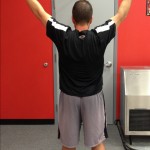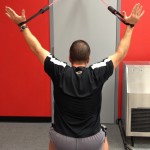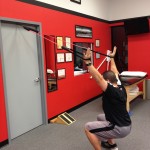Brian Schiff’s Blog
Injury Prevention, Sports Rehab & Performance Training Expert
I am currently writing up a series of corrective exercises related to the Functional Movement Screen (TM) that shows some common “go to” corrective drills I use on a regular basis. So, I will include those in my blog as I go since many people will benefit from the exercises to maximize mobility and stability.
I started off with a Deep Squat corrective exercise. If you are unfamiliar with the FMS, feel free to send me an email and I will send you a copy of a basic in-service I did on it to give you a better picture of the screening movements. Many issues can impact the overhead squat. While I often find ankle and hip mobility to be the primary limiting issues, an overlooked problem may include poor scapulothoracic stability. The resisted overhead squat will help correct deficiencies in that region.
Execution: I prefer to use a Cook band for this drill, however, you may also opt for tubing with handles or a TRX. The important thing is to use a partner or have whatever equipment you use firmly and safely anchored so you can squat without it giving way.
Begin in an upright position while looping the straps/handles over the back of the wrists or grabbing the handles with palms facing away from you. Slowly squat down as you actively retract the scapulae while keeping the arms in an overhead position. Pause at the bottom and return to upright. Adjust the distance from the anchor point to achieve the proper resistance level, keeping in mind that too much resistance will compromise form and result in a forward trunk lean.
Application: This is a very effective training exercise to facilitate proper scapulothoracic muscle activation. If a client has latissiumus, pec or teres major tightness, performing soft tissue mobilization beforehand is suggested. Cueing the client to actively pull the shoulder blades “down and back” is helpful in many cases. In many cases, they are so upper trap dominant they do not use proper motor patterns with overhead activity.
Regression: Instruct the client to do a forward facing overhead squat near a wall. Let them move close enough to where their fingertips nearly or just touch the wall at the bottom of the squat. The cues for muscle activation remain the same.
Progression: In the bottom of the overhead squat, instruct the client to hold while the trainer will provide some light perturbations of the bands to maximize neuromuscular activation and further groove the right pattern. Form should guide how much perturbation and once fatigue begins to impact control the exercise should stop. You may do fewer repetitions with this more advanced exercise.
As someone who works with high level athletes and those aspiring to take their performance to new levels, I think it is important to understand power development and the real “why” behind the exercises we choose. I also come at this from the side of a sports physical therapist who is working to get athletes back to their peak performance.
To that end, I am always looking for the most effective ways to train the neuromuscular system. Finding the most “specific” exercises for our clients is important. I thought I would provide a brief summery of a new article in the November 2013 Journal of Strength and Conditioning Research that looked to compare the neuromuscular characteristics of two types of jumps: hurdle and drop jumps. In addition, the authors wanted to examine three types of landing techniques:
- Preferred – athlete instructed to jump with a technique that allows for jumping as quickly and high as possible
- Flat foot
- Forefoot (FORE)
The working hypothesis was that hurdle jumps would be more powerful than drop jumps (DJs) and that foot flat technique would decrease mechanical power. The study included 25 subjects (male athletes) from Memorial University and during the jumps reaction forces, contact time, rate of force development (RFD) and lower limb EMG were measured.
All subjects did regular regular resistance training multiple plyometric drills with a typical volume of > 100 repetitions per session. However, none of the subjects had done drop jumps before. As such, this was the first test assessed to avoid fatigue. Subjects stood on a force platform and were asked to perform a maximal CMJ. Two trials were conducted with 1 minute of rest in between jumps. The maximum CMJ height was used to establish the DJ and hurdle height. The average flight time of the two trials was used to calculate jump height.
The order of DJ and hurdle jump tests was randomized with 5 minutes of rest between the jumps. The athletes did a 10 minute warm-up of cycling at 75 W-60 RPM followed by 5 sets of 5 sub maximal hopping, 5 single submaximal CMJ and 2 maximal CMJ. Only dynamic stretching was allowed during the warm-up to avoid any muscular power deficits created by static stretching.
Results
Contact time
- Hurdle jump had a 36.9% shorter contact time compared to DJ
- Preferred technique 29.1% shorter contact time than FLAT
- Preferred technique had 9.6% longer contact time than FORE
- FLAT 25.9% longer than FORE
- Jump and landing type interaction 23.8% shorter ground contact time for DJ FORE vs. FLAT
Vertical ground reaction forces (VGRF)
- Hurdle jump forces were 11% higher than DJ
- FLAT techniques revealed 30.8% less reaction force than preferred technique and 40.9% less than FORE
- DJ preferred technique had 14.9% more force than DJ FLAT
- DJ FLAT had lowest force level and was 25.9% less than DF FORE
Rate of force development
- Main effect of hurdle jump showed 46.3% higher RFD than DJ
- FORE technique 11.3% higher than preferred and 45% higher than FLAT
- Preferred technique 38% higher than FLAT
- DJ preferred 35% > DJ FLAT
- Hurdle jump preferred 40.9% higher than DJ preferred
- Hurdle jump FORE 43.6% higher than DJ preferred
- DJ FLAT was lowest for RFD
Leg stiffness
- Hurdle jumps were 64% stiffer than DJ
- Hurdle jump FORE had greatest stiffness
- DJ FLAT was the least stiff technique
EMG Activity
- Rectus femoris – HJ had 30% higher activity than DJ, eccentric phase highest, and FLAT higher than preferred and FORE
- Biceps femoris – HJ 68.8% more activity than DJ, concentric phase highest, and preferred higher than FLAT
- Tibialis anterior – FLAT had highest activity, eccentric phase highest
- Gastrocnemius – Preferred 26.3% > FLAT, FLAT 47% < FORE, and concentric phase highest
Key findings of the study
- Preferred and FORE hurdle jumps were more powerful plyometric exercises than the DJ based on a shorter contact time, higher VGRF, RFD and leg stiffness
- FORE and preferred landings produced the best results for all mechanical power variables
I like to include exercises on this blog that are useful for rehab and fitness professionals as well as fitness enthusiasts who visit. This is a cool exercise that a colleague taught me. I also recently shared this as part of my ‘Functionally Fit’ column for PFP Magazine. It works great when doing partner workouts or if coaching a client. We used it during our off season training for the Carolina Hurricanes and it is much harder than it looks on the surface.
Training clients to maintain core stiffness in athletic functional positions will improve performance and reduce injury risks for the spine and lower extremities. This exercise is an effective way to address postural stability, increase core strength and enhance kinetic chain proprioception

Execution
Begin in a split squat position holding a stability ball overhead. The client maintains an isometric split squat while the coach/trainer provides directional perturbations in an attempt to disrupt balance and stability.
You may opt for several quick rhythmic perturbations or elect to use more sustained pushes (1-2 seconds in each direction) to challenge the client. Allow the client to reset to the desired position if he/she does lose balance in order to facilitate optimal motor patterning. Perform 30 seconds with the left leg forward, rest 30 seconds and then repeat with the right leg forward. Complete two sets on each side.
Be sure to observe asymmetries or deviations specific to either side as this will allow for better cuing and reveal energy leaks. Marking the desired distance between the front heel and rear foot toes with tape will ensure consistency for each trial side-to-side.
As a parent, coach and sports physical therapist, this is a topic I am both passionate about and often confronted with. I remember growing up in a small town where I played a different sport every season. No one played year round soccer, baseball or AAU basketball – it was not even an option for those around me.
Now, I live and work in a competitive sports-minded environment where I see 13 y/o baseball pitchers with elbow and shoulder pain, 13 y/o female soccer players with ACL reconstructions, and too many adolescents suffering from overuse injuries like anterior knee pain and tendonitis. I witness coaches teaching 10 and 11 year olds to throw curve balls, hear athletes tell stories about how they are strongly encouraged or pressured to play only one sport if they want to excel and make a team, and parents who are pushing their kids hard at an early age in pursuit of college scholarships.
Is it all worth it? In a short answer – NO. In a recent article in the May/June 2013 issue of Sports Health, Jayanthi et al. performed a comprehensive search of PubMed and OVID from 1990-2011, gathering articles discussing sports specialization, expert athletes, or elite versus novice athletes including original research articles, consensus opinions, and position statements.
Click here to read the abstract
My own personal bias and opinion is that we should encourage youth to participate in multiple sports/activities and not pursue one sport or activity until they reach high school. I believe there is so much to be gained in terms of coordination, neuromuscular training, recovery and building general athleticism that gets lost with early specialization. However, I see many young athletes swept into early development programs and travel/AAU teams that naturally discourages or eliminates time/opportunities for other activities.
With that said, I will readily acknowledge that certain sports/activities (gymnastics and playing an musical instrument for example) do require an early commitment in terms of practice and skill mastery if one is to reach elite status. So, what should we as health and fitness professionals be telling our clients? How intensely do they need to train and at what age is it okay to focus on one sport?
I think we need to know what the evidence we have says and how we can best use knowledge to make meaningful change in society. In addition, we need to evaluate the mental and physical injuries that are occurring with the choice to specialize at a very young age. Consider that participation at age 6 and under has increased from 9 to 12% from 1997 to 2008.
So, for us to make a difference we need to investigate and scrutinize how we coach and train young athletes and become an advocate for their long term health as well as short term success.
Here are the key bullet points from the article I referenced above:
- Coaches are the most influential in beginning intense training and the decision to specialize
- Less than 1% of athletes 6-17 years old achieve elite status in basketball, soccer, baseball, softball or football
- Early diversification is more likely to lead to success based on multiple studies and may lead to more enjoyment, fewer injuries and longer participation
- Early diversification is more likely to lead to success based on multiple studies and may lead to more enjoyment, fewer injuries and longer participation
- Data currently suggests enjoyment of sport and intrinsic motivation predicts attainment
- Exposure is the most important risk factor for injury and there is a significantly increased risk for injury when participating > 16 hours/week
- Cumulative match exposure also carries a significant injury risk
- Prospective 10 year analysis of 481 youth baseball pitchers reveals a 3.5x increased risk for injury when pitching more than 100 innings per year
What about burnout? Consider the following:
- Swimmers who specialized early spent less time on the National team and retired sooner
- Minor league hockey players (boys) who dropped out started earlier and spent more time in off-ice training than those who continued to compete
- One retrospective review revealed that 1 out of 5 elite athletes reported injury as the reason for quitting
- In the end, the authors conclude that some specialization is necessary to attain elite skill, but the exclusion of other activities should be delayed until late adolescence.
To foster diversification, we must do a few things in sports medicine:
- Educate parents, coaches and athletes on the injury risk and facts about the impact of early specialization
- Promote the benefits of diversification in terms of joy, diminished stress to excel, athletic development and physical recovery
- Remind everyone involved not to take sports too seriously as only a very select few will move on to elite status, and instead encourage them to enjoy competing, learn to be a good teammate and reap the other rewards in sports (discipline, sportsmanship, learning to overcome adversity, working hard to achieve a goal, etc) that last well beyond a trophy presentation or game
I was just asked a few days ago by the parent of a 9 year old baseball player if I thought it was good for him to play multiple sports since he is pretty good in baseball. I encouraged this mother to have him do as many sports as he can for the next several years. Why put so much pressure on kids and expose them to increased injury risk? Every family and athlete needs to make their own personal decision, but for those who do opt for early specialization, I want to make sure I can help educate them on cross training, rest and recovery to minimize the risk for burnout and injury.
The FMS is a great tool to uncover asymmetry and movement dysfunction in fitness clients as well as patients in the clinic who are ready to transition back to sport. I have been using this tool consistently for 2.5 years in my practice. One of the questions I have asked myself about the screening tool is how reliable is it?

Click here for an earlier post I wrote on this topic regarding what it tells us as practitioners. One of the challenges with any screen or test is not only validity but reliability. In the April edition of the Journal of Strength and Conditioning Research, we gain some new insight regarding intra and interrater reliability via 2 new articles.
The first article discusses a controlled laboratory study where repeated measures were used to investigate how experience using the FMS and clinical experience as an athletic trainer (AT) affects the intrarater reliability of FMS testing. The raters (17 men and 21 women who were recruited from the university’s athletic training clinical staff and academic programs), with different levels of FMS and clinical experience (AT students, AT or AT with at least 6 months experience using the FMS) viewed each of the 3 videotaped models.
None of the AT students or AT members had seen or used the FMS previously compared to the AT group with at least 6 months of experience. Each group rated the models on each of the FMS exercises according to the script presented by the lead investigator. A week later the raters watched the same videos again in a different randomized order and rated each model on each exercise.
The intersession scores were examined to establish intrarater reliability of all participants. In addition, the intrarater reliability of different groups of participants (students and clinicians) was compared to infer differences about the influence of clinical experience as an AT along with previous experience using the FMS.
Results:
- Average FMS score was 13.68 +/- 0.98
- There was moderate intrarater reliability was observed when all participants were analyzed
- The AT group with experience had the strongest intrarater reliability followed by the AT group (no experience)
- The AT students demonstrated poor reliability with a large 95% confidence interval
Key takeaways:
- Previous research by Minick et al. had established excellent agreement on all components of the FMS among expert and novice raters indicating strong interrater reliability, but authors point out that is first study to look at intrarater reliability
- This helps establish reliability of assessment giving more credibility to using it as an effective assessment tool
- All raters were either AT’s or AT senior undergraduate students – need to include other professionals in future studies to confidently apply the external validity of the results in this particular study
- Primary limitation of this study is the fact that video was used as opposed to live assessment
- Possessing clinical experience and experience with the FMS strengthens intrarater reliability so learning to use the tool with other experienced clinicians may be wise to improve validity







